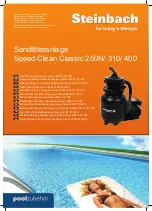
14. Operating and Check-Out Procedures
1. Final Visual Inspection
Check the following items:
•
Verify that the check valves, control valves and vacuum breakers are installed properly.
•
Verify that all plastic collector clamp clips are tight.
•
Verify that all lag bolts are secure and that adequate sealant was used to prevent any roof
leaks.
•
Be sure all collector riser tubes are snapped into the spacer bars (except where they go around
obstructions).
•
Be sure that collector riser tubes are NOT rubbing on the roof surface between spacer bars. If
they are, adjust spacer bars as needed to prevent this or a hole may develop in the riser tube.
•
Be certain that the system will automatically drain down when the pump is shut off or that
enough manual drain valves have been included.
•
Verify that all pipe runs are properly supported with pipe clamps.
2. Turning the System On
• Turn
off the pool pump.
•
Turn the 3-way valve so that the “closed” indicator points toward the pool side of the valve.
•
Be sure that the ball valves on the feed and return lines are open.
•
Turn the pool pump on.
•
Set the pool pump timer, if used, so that the pump will run when sun is shining on the solar
collectors. Usually 10:00 AM to 4:00 PM, but this will vary with geographic location, time of
year and the compass location of the system.
•
When the solar system is running, you should notice: “Aslightly higher pressure reading on the
pressure gauge”.
At midday, if the sun is out, warmer water should be coming into the pool. This water should
be 3 to 5 degrees warmer than the pool temperature.
All the collectors should feel cool to the touch when the sun is on them. (If they are not, see
the troubleshooting section).
•
During the cooler months of the year, it is essential that the pool surface be covered at night
with a “pool blanket” to maintain a comfortable water temperature. Low nighttime tempera-
tures can lower the water temperature more than the solar can recover during the day.
29
Solar Pool System
Installation Manual




































